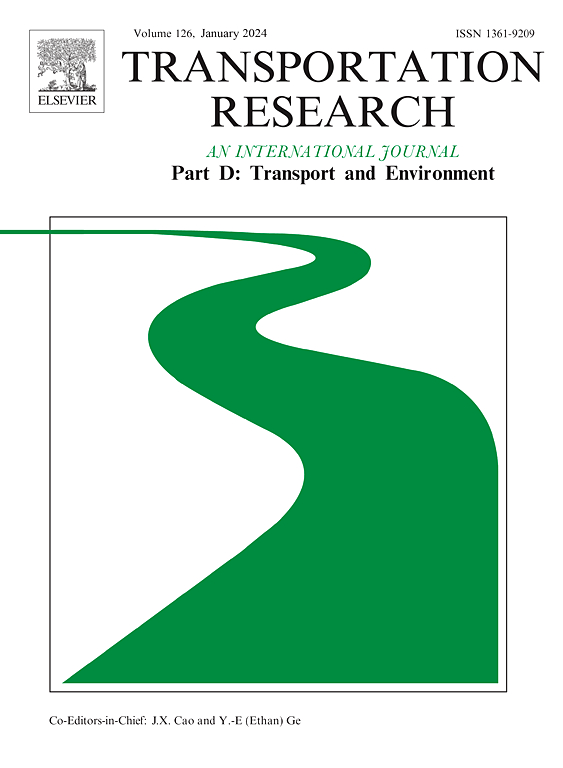Assessment of full-process VOCs emissions of on-road vehicles considering individual parking behaviors
IF 7.3
1区 工程技术
Q1 ENVIRONMENTAL STUDIES
Transportation Research Part D-transport and Environment
Pub Date : 2025-02-28
DOI:10.1016/j.trd.2025.104678
引用次数: 0
Abstract
Vehicle-emitted volatile organic compounds (VOCs) significantly contribute to ozone (O3) formation, affecting health and environment. Prior studies focused on exhaust emissions, often overlooking evaporative emissions due to a lack of detailed parking behaviors, underestimating total VOCs. Using automated vehicle identification (AVI) data from Xuancheng, this study developed a full-process VOCs emission model covering both exhaust and evaporative emissions. Findings show that 80 % of vehicles are parked for over 90 % of the day, with parking behaviors causing significant emissions variations among vehicles. Total VOCs emissions were 44.46 tons from April 15 to May 15, 2022. Specifically, exhaust, diurnal, running losses, and hot soak emissions were 59.2 %, 24.2 %, 14.9 %, and 1.7 %, respectively, with parking emissions at 25.9 %. During Labor Day, reduced traffic and increased parking raised daily VOCs emissions, with parking emissions rising to 33.4 %. This underscores the need to consider evaporative emissions and parking behaviors in emission management and pollution control.
考虑个体停车行为的道路车辆全过程VOCs排放评价
汽车排放的挥发性有机化合物(VOCs)显著促进臭氧(O3)的形成,影响健康和环境。先前的研究主要集中在废气排放上,由于缺乏详细的停车行为,往往忽略了蒸发排放,低估了总挥发性有机化合物。利用宣城的车辆自动识别(AVI)数据,建立了包括排气和蒸发排放在内的全过程VOCs排放模型。研究结果显示,80%的车辆每天90%以上的时间处于停车状态,停车行为导致车辆之间的排放差异很大。2022年4月15日至5月15日,VOCs总排放量为44.46吨。具体来说,排气、日间、运行损失和热浸排放分别为59.2%、24.2%、14.9%和1.7%,停车排放为25.9%。劳动节期间,交通减少和停车增加导致日VOCs排放量上升,其中停车排放量上升至33.4%。这强调了在排放管理和污染控制中考虑蒸发排放和停车行为的必要性。
本文章由计算机程序翻译,如有差异,请以英文原文为准。
求助全文
约1分钟内获得全文
求助全文
来源期刊
CiteScore
14.40
自引率
9.20%
发文量
314
审稿时长
39 days
期刊介绍:
Transportation Research Part D: Transport and Environment focuses on original research exploring the environmental impacts of transportation, policy responses to these impacts, and their implications for transportation system design, planning, and management. The journal comprehensively covers the interaction between transportation and the environment, ranging from local effects on specific geographical areas to global implications such as natural resource depletion and atmospheric pollution.
We welcome research papers across all transportation modes, including maritime, air, and land transportation, assessing their environmental impacts broadly. Papers addressing both mobile aspects and transportation infrastructure are considered. The journal prioritizes empirical findings and policy responses of regulatory, planning, technical, or fiscal nature. Articles are policy-driven, accessible, and applicable to readers from diverse disciplines, emphasizing relevance and practicality. We encourage interdisciplinary submissions and welcome contributions from economically developing and advanced countries alike, reflecting our international orientation.

 求助内容:
求助内容: 应助结果提醒方式:
应助结果提醒方式:


